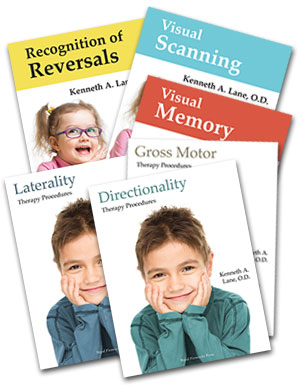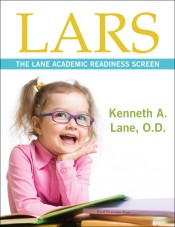Dr. Kenneth Lane has created a reading therapy program based upon his own research plus decades of work in vision therapy. The program is based upon use of the LARS: The Lane Academic Readiness Screen. While the title might make you think this is an assessment to determine whether or not children are ready to start a particular grade level, its purpose is rather to highlight potential problem areas that might interfere with learning, particularly reading.
LARS is intended to be used with children in kindergarten through second grade, but you should also use it if you have older children who continue to have difficulties with reading.
LARS is available either free online or as a printed book. For most homeschoolers, I would recommend that they use the online assessment. The printed book has some additional information, but most of it is included online with the LARS assessment under different tabs. I recommend, in particular, that parents read the section under the “about” tab.
If you use the print book, you need to analyze the results yourself, a process which is a bit complex. On the other hand, the online assessment automatically analyzes the assessment and immediately gives you printable results. The analysis highlights areas of potential difficulty, explaining why each might be a problem area. Then it recommends a selection of the packages of therapy books by Dr. Lane for a do-it-yourself therapy program.
 Developmental areas that LARS targets are directionality, laterality, sequencing, gross motor skills, ocular motor skills, visual motor skills, simultaneous processing, and vision in general. If a child has general vision problems, the report from the online assessment will recommend that the child be evaluated by a developmental optometrist. For the other seven areas, Dr. Lane has created packages with from three to seven books in each. Books present therapy activities or exercises that parents can easily direct at home without professional assistance. Each book seems to have between 40 and 70 pages. The inclusion of comprehensive explanations, illustrations of activities when needed, and charts or other “tools” give you much of what you need. You will still need other resources for some activities. Books vary in the number of resources required. For example, the Spelling Tracking Perceptual Training Workbook requires nothing other than the pages within that book while Ocular Motor Therapy Procedures requires many resources: either a chalkboard and chalk or a whiteboard and markers, a metronome, a suspended ball, a dowel rod painted with colored sections, an eye patch, a balance beam (or something that works like one), index cards, push pins, a wooden yardstick, a length of string with a few beads tied on it, and a laser pointer. Most items are easy to construct from inexpensive materials, although the trampoline called for in Gross Motor Therapy Procedures is a more significant expenditure.
Developmental areas that LARS targets are directionality, laterality, sequencing, gross motor skills, ocular motor skills, visual motor skills, simultaneous processing, and vision in general. If a child has general vision problems, the report from the online assessment will recommend that the child be evaluated by a developmental optometrist. For the other seven areas, Dr. Lane has created packages with from three to seven books in each. Books present therapy activities or exercises that parents can easily direct at home without professional assistance. Each book seems to have between 40 and 70 pages. The inclusion of comprehensive explanations, illustrations of activities when needed, and charts or other “tools” give you much of what you need. You will still need other resources for some activities. Books vary in the number of resources required. For example, the Spelling Tracking Perceptual Training Workbook requires nothing other than the pages within that book while Ocular Motor Therapy Procedures requires many resources: either a chalkboard and chalk or a whiteboard and markers, a metronome, a suspended ball, a dowel rod painted with colored sections, an eye patch, a balance beam (or something that works like one), index cards, push pins, a wooden yardstick, a length of string with a few beads tied on it, and a laser pointer. Most items are easy to construct from inexpensive materials, although the trampoline called for in Gross Motor Therapy Procedures is a more significant expenditure.
The author does not recommend that this reading therapy program be used as a substitute for professional evaluation. However, his resources provide what can be a very comprehensive program covering a multitude of activities that are generally recommended for overcoming various learning or vision difficulties. If anything, the fairly general nature of the recommendations from the online LARS might indicate that a child should complete more of the therapy packages than are actually needed. However, the report does state a percentage probability regarding whether each area should be of concern. Personally, I would probably target the areas with highest probability rather than try to use too many packages. As Dr. Lane recommends, obtaining a professional consultation as well will help you better determine which packages are most helpful.
Samples schedules in the print LARS book recommend that children spend about one hour per day for five days per week, using activities from the different packages each day. Most likely you will complete four or more activities per day spending 10 to 15 minutes per activity. Activities in each booklet or else levels within particular activities gradually become more challenging, so while you might repeat some activities, you will gradually take a child through all or most of the activities within each book over the course of about four months. You can see that if you are trying to work through too many packages simultaneously it could be very confusing and much too time consuming.
While you can purchase all of the books individually, they are designed to work as complementary sets within each package rather than as stand-alone books.
This reading therapy program is still being developed further as I write this review. Dr. Lane originally wrote a book Developing Your Child for Success. While the book was very helpful, it was challenging to move through an easy process from assessment to a prescriptive program that was easy to implement. This totally revamped approach makes it much easier to use Dr. Lane’s approach. It seems to me that the biggest challenge now is to prioritize from your results so that you end up with a manageable program. Again, consultation with a professional might help with this. Also, I’m not certain that it is clear that when you implement a program you are to use activities from different books each day rather than plowing through one book at a time. This approach is important since it is much more holistic in tackling potential problem areas, and the variety of activities will prevent boredom from repetition.
In my experience, many expensive therapy programs seem to use many of the same techniques that Dr. Lane includes in these books. When parents are empowered to provide therapy themselves, they can save a great deal of money. Simultaneously, parents will become thoroughly familiar with which areas are most challenging for their children and need to be addressed to help their children advance in their learning to the best of their capabilities.









